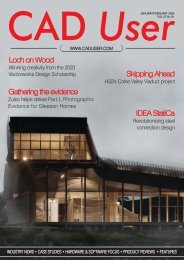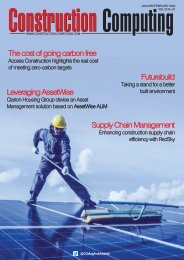You also want an ePaper? Increase the reach of your titles
YUMPU automatically turns print PDFs into web optimized ePapers that Google loves.
TECHNOLOGYfocus<br />
Get Smart<br />
Matthew Margetts, Director of Sales and Marketing of Smarter Technologies Group explains why you<br />
can't ignore building data management<br />
The world around us is becoming<br />
increasingly connected, which has<br />
only been further accelerated by the<br />
COVID-19 pandemic. Today's building<br />
owners and developers are reimagining<br />
and transforming their premises to create<br />
healthy indoor environments and adopt<br />
building-centric Internet of Things (IoT)<br />
offerings. Building owners who<br />
understand emerging smart building<br />
technology trends and data management<br />
will be positioned at the forefront of<br />
innovation and be able to command<br />
higher valuations for their properties.<br />
The good news is that today's<br />
sophisticated software uncovers<br />
opportunities and improves building<br />
performance for the long run, allowing<br />
building owners to reap the cost-saving<br />
benefits of analytics.<br />
Imagine using smart management<br />
systems to continuously offer simple and<br />
meaningful information about what is<br />
happening inside a building. This data can<br />
be used to:<br />
Develop smarter maintenance protocols<br />
Increase efficiency<br />
Create a healthier building environment<br />
Lead to happier tenants<br />
Improve environmental, social, and<br />
governance (ESG) tactics and reporting<br />
Work towards net zero goals<br />
On the flip side, a building with no analytics<br />
in place leads to equipment breaking down,<br />
issues with temperature and air quality,<br />
costly downtime and massive inefficiencies<br />
that affect the organisation's bottom line and<br />
carbon footprint. Without concrete data at<br />
your disposal, you don't have the<br />
information you need to resolve these<br />
issues as quickly as possible (never mind<br />
detecting them in the first place). Simply<br />
put, if you're not capitalising on data<br />
analytics in buildings in <strong>2022</strong>, you're not<br />
building or operating a truly smart building,<br />
and you're losing a competitive edge.<br />
SMART DATA ANALYTICS<br />
Collecting the data is one thing, but its<br />
usefulness is only as good as its<br />
management and analysis. A robust system<br />
will simplify and analyse complex data<br />
patterns to conduct root-cause analysis and<br />
monitor equipment and energy use. This<br />
allows building managers to optimise<br />
operations and prioritise opportunities to<br />
reduce costs, enhance sustainability, and<br />
improve occupant comfort.<br />
A smart building comprises a system of<br />
connected sensors transmitting data via a<br />
secure network to intelligent data analytics<br />
software that offers insights for automation,<br />
maintenance, and efficiency opportunities.<br />
Fitted to assets and equipment you<br />
would like to track and manage,<br />
sensor technology can also be built<br />
into assets and everyday items by<br />
default. To illustrate this point,<br />
picture an office building.<br />
Environmental sensors can<br />
monitor the environmental<br />
conditions of the office, such as<br />
temperature, humidity, lighting, noise, and<br />
indoor air quality; light sensors can monitor<br />
and automate the brightness of the room;<br />
occupancy sensors measure space<br />
utilisation, such as desk occupancy; and<br />
biometric scanners and cameras can<br />
control access. The data from these<br />
sensors and applications is transferred via a<br />
data network (which could be WiFi, GPS,<br />
RFID, WiMAX, WPAN, Bluetooth, GSM, or a<br />
combination) to your cloud solution for<br />
analysis and reporting. The only limit on<br />
sensors is very often the imagination, and,<br />
specifically, not having a solution that can<br />
integrate them properly.<br />
One example of a holistic smart system is<br />
Smarter Technologies' SmarterView building<br />
data management platform which provides<br />
powerful, real-time insights that allows<br />
facilities managers to optimise their<br />
operations, using smart sensors and tags<br />
turn everyday objects into smart IoT<br />
devices,transmitting data from tags<br />
wirelessly, which they can then monitor and<br />
control in real time.<br />
This comprehensive asset management<br />
overview allows for immediate action,<br />
automation and analysis. Through smart<br />
data analytics, buildings benefit from<br />
system-wide opportunities for building a<br />
healthier environment, developing<br />
efficiencies, and improving comfort levels<br />
for tenants - whilst, at the same time,<br />
reducing overhead expenditure.<br />
THE BENEFITS OF SMART DATA<br />
A building management system that<br />
includes smart data analytics offers<br />
numerous benefits for building owners:<br />
System-wide, high-level data capture of<br />
an entire estate and operations<br />
Healthier building environments through<br />
air quality control and HVAC monitoring<br />
The ability to balance energy load during<br />
low occupancy or off-peak periods<br />
Eliminating waste by analysing sensor<br />
data<br />
30<br />
<strong>Jul</strong>y/<strong>Aug</strong>ust <strong>2022</strong>

















